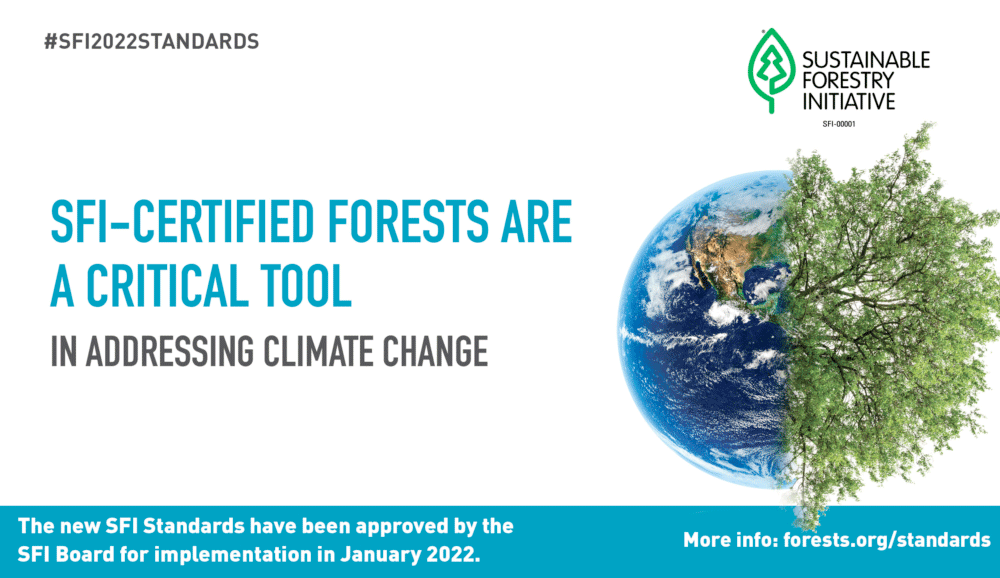Climate Smart Forestry
Climate change is generally defined as the long-term shifts in temperature and weather patterns. Some climate change occurs naturally, but human activity over the last several hundred years has significantly increased climate change effects through the burning of fossil fuels such as coal, oil and gas. Burning these fuels creates greenhouse gasses, which leads to increased temperatures.
Our forests play an important role in the carbon cycle and in reducing the amount of carbon dioxide in the atmosphere (carbon dioxide is one of the leading greenhouse gases). As trees grow, they use carbon dioxide from the atmosphere during photosynthesis. Additionally, older forests act as a carbon ‘sink’ (i.e., they store carbon), which later releases after they expire or through a disturbance such as fire, insects, disease or harvesting. These carbon cycles are called carbon sequestration. Both carbon sequestration from younger forests and carbon sinks from old forests are an important part of the solution.
There are two important ways Mosaic actively manages our forest lands and activities to mitigate climate change:
1) Manage our forests to sequester greenhouse gases through prompt reforestation of harvested areas, maintaining forest health, and conserving old forests to provide carbon sinks. These carbon cycles are called carbon sequestration.
2) Reduce greenhouse gas emissions, through the reduction of tailpipe emissions from operational activities.
Certification and Climate Smart Forestry
Mosaic is committed to ensuring sustainable forest management of our forests. This commitment includes certifying all our forest lands to the Sustainable Forestry Initiative® (SFI®) Forest Management Standard.
One aspect of sustainable management includes consideration of the current and potential future impacts for the forest landscape due to climate change. To ensure that our forest management planning incorporates and considers climate change, Mosaic has a climate solutions strategy to help guide our forest management activities, and ensure our activities include aspects of Climate Smart Forestry from the SFI Forest Management Standard.
Mosaic’s Climate Solutions Strategy
To help guide our forest management planning and activities, Mosaic has developed a climate solutions strategy that is consistent with the Climate Smart Forestry objectives of the SFI® Forest Management Standard.
Mitigation and adaptation are the primary focus areas of our strategy and are divided into five key categories. Mosaic is committed to measuring the carbon balance of our business in a transparent and scientific way. The goal is to be a net-zero organization by 2035, and from there become a positive sequestration business. The pathway to net zero includes strategies to calculate and reduce our emissions.
-
Operational strategies to support the pathway to net zero include the use of electric fleet vehicles and logging trucks as well as forest protection measures related to wildfire.
To prevent carbon emissions from wildfire, our prevention measures involve completion of post-harvest assessments on our timberlands including fire hazards associated with the coarse woody debris. Mosaic also has a dedicated forest protection team to ensure prompt response to wildfires in our forest lands. This also includes centralized fire fighting equipment caches and trained fire-fighting personnel. We also maintain collaborative agreements with neighbors and the Ministry of Forests to help facilitate quick action to extinguish fires.
-
To reduce greenhouse gas emissions, Mosaic has made significant reductions in the amount of post-harvest debris burning over the last several years by continuously improving utilization, including greater use of small logs to reduce waste. For residual debris that still needs to be addressed to ensure replanting, we continue to use new on-site chipping methods.
-
In 2021, Mosaic began work on the BigCoast Forest Climate Initiative. The project was announced in Spring 2022 and includes conserving old forests on 7% (40,000 hectares) of our private timberlands on Vancouver Island and Haida Gwaii for at least 25 years, as part of a market offering for other companies that need high quality carbon credits as one part of their footprint reduction programs. These forests will provide valuable carbon sinks that will store and remove carbon dioxide from the atmosphere and help to mitigate the broader impacts from climate change.
-
Our staff works closely with experts to generate climate modeling that analyzes weather patterns to guide strategic and operational planning. Strategies include reviewing road crossing infrastructure to ensure it is adequate for expected extreme weather conditions. These tools help our forest planners and managers make the best adaptations to expected extreme weather events.
-
Mosaic promptly reforests all our harvested areas with ecologically suitable tree seedlings. Following planting, our forestry team carefully monitors the young forests to ensure that they remain healthy and develop into new forests. Climate change strategies related to silviculture planning include utilizing available prediction tools for future ecosystem shifts, adjusting planting schedules to ensure optimum weather conditions for seedling survival and closely monitoring our forests for early detection of any forest health concerns.


